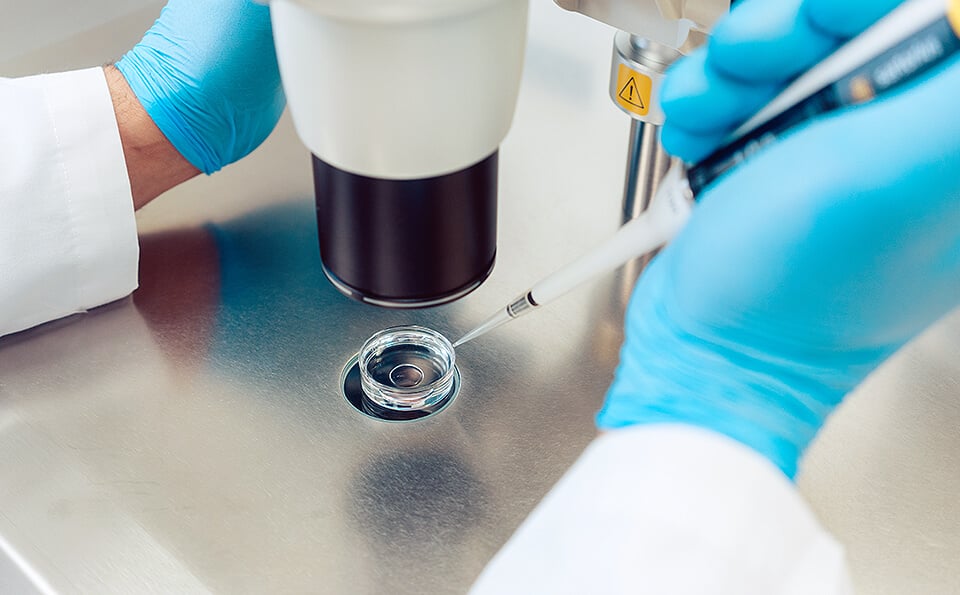
Embryo Implantation, How To Make An Embryo Stick
Pacific Fertility Center is re-engineering fertility care, helping women conceive pregnancy faster, easier and more safely.
To initiate pregnancy, a healthy embryo is required, but also the uterine lining must be able to receive the embryo; the embryo must implant. Efficiency of implantation is an important predictor of pregnancy rates. A highly efficient endometrium allows healthy embryos to attach, while an inefficient endometrium may refuse a healthy embryo.
We know that the uterus is inefficient at implantation. About 20-30% of healthy embryos that arrive in the uterus do not implant, on average. The reasons for failure to implant are complex and not easily treated with current technology. At Pacific Fertility Center we understand the importance of this problem, and are researching ways to optimize implantation.
One of the ways we can improve implantation is by accurate delivery of the embryo to the endometrium. Using ultrasound we can see the tip of the transfer catheter in the uterus, guiding it into proper location. Ultrasound guidance for embryo transfer allows placement of the embryo into the best part of the endometrium, and verifies accurate placement. Placement is the first step to implantation.
Negotiating the cervical curvature can be a problem in some women. The cervix is the pathway by which an embryo catheter is inserted; women vary widely in the structure and position of the cervix. The most frequent position of the uterus is anteverted, that is, directed toward the front, with a gentle cervical curve. A retroverted, or "tipped" uterus, is not uncommon, and is sometimes accompanied by a tight curve that makes transfer more difficult.
Prior medical treatment of the cervix, such as LEEP or cone biopsy, could be another source of difficulty. These situations require special attention to transfer. We routinely perform a mock embryo transfer some time before the real one, to map the pathway and verify any special methods that might be required.
We continue to evaluate methods to improve embryo implantation. One technique is the endometrial scratch, which removes a bit of the surface layer of the endometrium some weeks before the transfer. In effect the surface of the lining is roughened up a bit, giving more area for the embryo to attach. Limited studies suggest that the scratch may be useful in some patients. PFC is continuing to evaluate this technique.
We are also evaluating molecular biology techniques to assess implantation. The ERA assay, from Ivigen, measures specific genes expressed in the endometrium when it is ready to receive the embryo. The ERA assay allows adjustment of the date of transfer to optimize implantation. We are continuing to evaluate this technology, and offering it to suitable patients.
Some research has expressed support for various uterine infusions, such as hCG and filgrastim (Neupogen) in enhancing the receptivity of the uterus. More detailed randomized controlled trials now being published have not, in general, confirmed early work, so uterine infusions are of limited use.
Implantation efficiency is becoming critically important in combination with new technologies like Comprehensive Chromosome Screening (CCS), which allows us to screen embryos for health, and transfer only healthy embryos, one at a time. A healthy embryo is incredibly valuable; however, the uterus also needs to be as receptive as possible to maximize its potential to produce a pregnancy.
We continue to work on improving implantation efficiency, allowing each embryo to reach its maximum potential for pregnancy, the first step to a healthy child.
Conceiving a pregnancy faster, easier, and more safely, is what you will experience in your care at Pacific Fertility Center. We are literally re-engineering traditional fertility care, optimizing each step, to improve your outcome, with the goal of helping develop your family, one healthy baby at a time.
— Philip Chenette, M.D.
PFC Physician
Categories
About the Blog
Welcome to the Pacific Fertility Center Blog! Nationally and internationally recognized for providing exceptional reproductive care, our team believes in empowering people with the knowledge they need to navigate their unique fertility journeys.
From information on the latest fertility treatments to valuable insights on egg donation, surrogacy, and everything in between, the Pacific Fertility Center Blog is your ultimate resource for all things reproductive care and support. Read on to learn more, and contact us today if you have any questions or want to schedule a new patient appointment.

